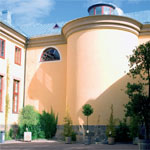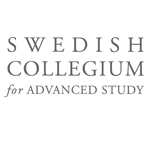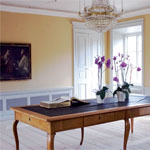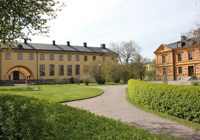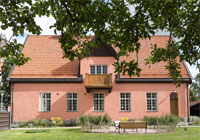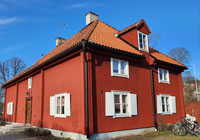Buildings and Grounds
The Swedish Collegium for Advanced Study is located in the late eighteenth-century Linneanum and the
adjacent
late nineteenth-century Prefektvillan in the middle of the Botanic Garden in Uppsala, as well as in
the early
twentieth-century Villa Therese
Andersson, just across the street, and the nearby eighteenth-
century Villa Lugnet.
Linneanum
The Collegium moved into Linneanum in January 2007. Commissioned by King Gustavus III and constructed
from 1787 and onwards, Linneanum was finally inaugurated in 1807 to mark the 100-year celebration of the
birth of the world-renowned Swedish botanist Carl Linnaeus (1707–1778).
Designed by the royal architects Olof Tempelman and Louis Jean Desprez, the building stands out as a monument
to science and enlightenment in the neoclassicist style of the late eighteenth century. Linneanum’s temple-like
front faces the Baroque Garden, which was designed by the royal architect Carl Hårleman and dates from 1750.
The Collegium is housed in Linneanum’s northern wing, which has been carefully restored and renovated to
preserve the building’s antiquarian values while providing modern offices and communal spaces for research.
The architect in charge of the renovation – Professor Andreas Heymowski, also architect for the Royal Palace
in Stockholm - has used materials and colour schemes that correspond to the building’s original exterior and
interior. Where a thoroughly antiquarian approach has not been possible, modern quality materials and design
have been used.
Of particular importance in the restoration programme are three great halls: the Thunberg Dining Hall (Thunbergs
matsal), the former dining room of Linnaeus’ successor, Carl Peter Thunberg, which serves as the Collegium’s
reading room (and occasionally as a dining hall), and the Thunberg Lecture Hall (Thunbergssalen), a lecture hall
with a capacity to seat ninety people in a historical room furnished with state-of-the-art audiovisual equipment.
Although not part of the Collegium’s new premises, the Thunberg Lecture Hall opens up directly to the Linnaeus
Hall (Linnésalen), whose proportions and décor, crowning dome and re-erected statue of Linnaeus underline the
building’s classicist ideals. The Linnaeus Hall is used for exhibitions etc. Linneanum is a national heritage building.
Prefektvillan
In September 2011, the Collegium moved parts of its organisation into the newly restored Villa. Designed by the
architect Emil Viktor Langlet and built in 1894, the Villa was originally intended and used as the private residence
of the Main Professor of Botany at Uppsala University. The Villa has a number of important stylistic features, both
exterior and interior, that were characteristic of nineteenth-century Swedish architecture. Much work has gone
into renovating the interior of the building so as to reflect its original distinctiveness and design. An overarching
task has been to safeguard the building’s cultural and historical value, and its unique place in the settings of the
Botanic Garden has been an especially important feature of that work.
The Swedish Collegium for Advanced Study – with its naturally integrated place in Linneanum and the Botanic
Garden – has taken great care to preserve and promote this unique heritage.
Villa Therese Andersson
As of January 2017, the Swedish Collegium is extending its activities so as to include yet another building, namely
the beautiful early twentieth-century villa that is often referred to as Villa Therese Andersson. The Villa is located
just across the street from the Botanic Garden. The physical expansion is a natural result of the recent effort
of the Collegium to expand its activities into the natural sciences.
Designed by architect Ernst Stenhammar, the Villa was built in 1912-13. The Villa’s stylistic features, both
exterior and interior, are characteristic of the period’s Art Nouveau style (Jugendstil) with many distinct influences
from the Arts and Crafts movement. During 2016, the Villa has been carefully restored and renovated to provide
modern office and living spaces, at the same time as its historical and cultural values have been preserved.
The name of the Villa is in reference to Mrs Therese Andersson, who, in 1910, donated SEK 40 000 to Uppsala
University in memory of the late Professor of Physics, Knut Ångström. The aim of the donation was to provide
a private residence for the Main Professor of Physics at Uppsala University. During the years, the Villa has been
the home of no less than two Nobel Prize Laureates, namely Manne Siegbahn (the Nobel Prize in Physics, 1924)
and Kai M Siegbahn (the Nobel Prize in Physics, 1981).
Villa Lugnet
Villa Lugnet dates back to 1734 and was initially the home of the gardener responsible for the pleasure garden
and kitchen garden belonging to Uppsala Castle. In 1787, the pleasure garden was donated to the Academy
by King Gustavus III and the lease of the kitchen garden was eventually transferred to the Academy gardener.
Villa Lugnet remained a gardener's residence until around the mid-nineteenth century, providing accommodation
for the Academy Gardener in the decades around 1800, and from 1813 for the gardener at the service of the
Governor of Uppsala County. Facing the threat of teardown in the early 1900s, the villa was instead turned
into the home of the head of the local prison in 1917. In the 1940s, the villa went through a thorough restoration,
and after that it has been used for multiple purposes serving both as a private residence and as study centre.
In 2021-22, the villa was carefully restored again and added to the campus of the Swedish Collegium. As of
September 2022, it houses offices and a meeting room for SCAS Fellows and visiting research groups.




